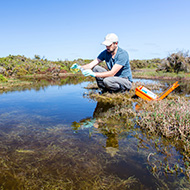Vets heal 800kg rhino’s leg in world first procedure
The veterinary team relied on their equine experience when treating Amara's fractured ulna.
A team of equine veterinary surgeons from the University of Liverpool’s Leahurst Equine Hospital has worked with Knowsley Safari to help heal a rhino’s broken leg.
Amara, a southern white rhinoceros, required a ground-breaking procedure after she was diagnosed with a fractured ulna.
The one-year-old rhino first came to public attention in October 2022, when her birth was discussed on Channel 4’s Secret Life of the Safari. Amara has since become well-known among the safari’s animal keepers for her boisterous play and sparring sessions with other rhinos.
Earlier this year she began limping on her right leg, and was put on rest and pain relief by the Knowsley Safari team.
After an assessment, the animal keepers called in specialist equine surgeons from the University of Liverpool’s Leahurst Equine Hospital to provide a diagnosis. A radiograph confirmed that Amara had suffered a fractured ulna.
There had been no previous records or documentation on treating this type of leg injury in rhinos, and so the team relied on their experience with treating horses to help Amara.
Amara was put under anaesthesia inside her enclosure before a large team of veterinary surgeons began the procedure. This saw them perform key-hole surgery on Amara’s wrist in an operation which lasted five hours.
Although the team knew they could position a camera within her joint, they did not know how much space they’d have to operate or how much of the area they’d be able to see.
After her operation, Amara wore a full limb cast and was kept within her enclosure to minimise movement. The veterinary surgeons were hopeful the cast would be strong enough and that she would cope with the restricted movement.
The animal keepers kept Amara comfortable, giving her lots of bedding and keeping her in the company of her mother, Meru. They also provided the rhinos with lots of mud to keep their skin in good condition.
Eventually she was back on her feet again and, after first being moved to a small paddock, was soon back in the wide open spaces of the Safari Drive.
To support her ongoing healing, the veterinary surgeons injected Amara’s affected joint with platelet rich plasma (PRP). The solution was derived from Amara’s own blood, and contained platelets to support the repair process.
David Stack, senior lecturer in equine surgery at the University of Liverpool, said: “Treating Amara has been a truly ground-breaking veterinary journey incorporating many firsts which we will now document should another animal team encounter similar scenarios in the future, though we very much hope the notes are never needed.”
Image © University of Liverpool



 A set of international guidelines for disease surveillance in wildlife has been updated for the first time since 2015.
A set of international guidelines for disease surveillance in wildlife has been updated for the first time since 2015.